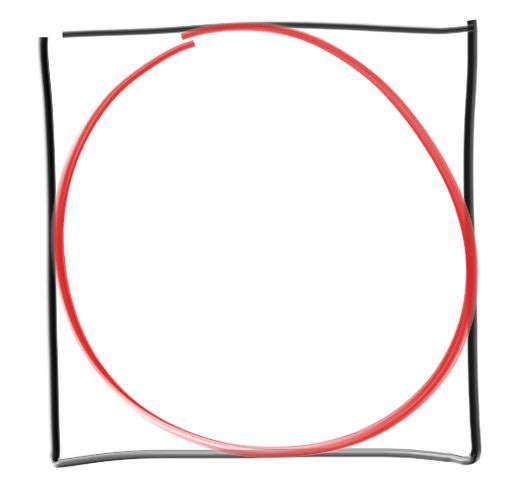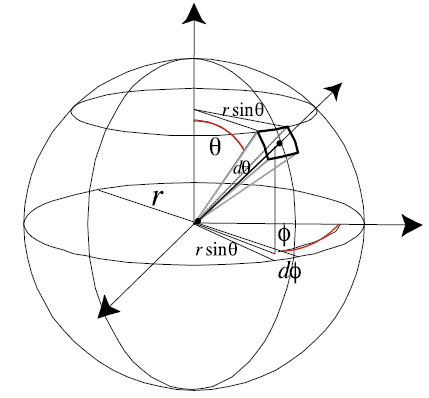Ray Tracing-The Rest of Your Life
Ray Tracing-The Rest of Your Life
1. 蒙特卡洛采样
- Monte Carlo (MC)
 \[
\dfrac{\pi r^2}{(2r)^2}=\dfrac{\pi}{4}
\]
\[
\dfrac{\pi r^2}{(2r)^2}=\dfrac{\pi}{4}
\]
(1) Stratified Samples (Jittering)
- 我们很快能够得到一个 \(\pi\)
的估计,但是收敛的很慢
- 收益递减定律:law of diminishing return
- 可以通过分层来降低影响

1 | // 常规的 MC |
1 | Regular Estimate of PI: 3.1416273200 |
- 效果确实好了,估计得更准确,收敛的也更快
- 为什么呢?分层采样的方差更小
- 分层采样的方差分析
- 这个优势会随着维度的增加而递减,例如把上面的代码应用到 3D
的球和正方体,用体积占比算 PI
- 维度的诅咒: Curse of Dimensionality
2. 一维 MC
例子
\[ I=\int_{0}^{2}x^2\;\mathrm{d}x \]
- \([0,2]\) 上均匀采样,\(p(x)=\dfrac{1}{2}\)
\[ \hat{I}=\dfrac{1}{N}\sum_{i=1}^{N}\dfrac{X_i^2}{p(X_i)}=\dfrac{1}{N}\sum_{i=1}^{N}2X_i^2 \]
- 结果如下:\(\dfrac{8}{3}\)
1 | 2.6671368997 |
- MC 适用于一些很难显式求出积分的问题,例如
\[ I=\int_{1}^{2}\log(\sin x)\;\mathrm{d}x \]
- pdf:probability density function
- \(p(x)\)
\[ \int_{\infty}^{\infty}p(x)\;\mathrm{d}x=1 \]
- cdf:cumulative probability distribution function
- \(F(x)\)
\[ F(x_0)=\int_{-\infty}^{x_0}p(x)\;\mathrm{d}x \]
采样特定分布
- 如何从一个均匀分布采样得到另外一个分布呢?
- 目标 cdf 为 \(F(x)\),目标 pdf 为 \(p(x)\),\(p(x)\) 在 \([0,1]\) 上非零,\(U\) 表示 \([0,1]\) 上的均匀分布
- 我们需要找函数 \(f(u(x))\),使得 pdf 为 \(p(x)\)
- 设 \(X=f(U)\)
\[ \begin{aligned} F(x)&=\Pr(X\le x)\\ &=\Pr\Big(f(U)\le x\Big)\\ &=\Pr\Big(U\le f^{-1}(x)\Big)\\ &=f^{-1}(x) \end{aligned} \]
- 于是有
\[ f(x)=F^{-1}(x) \]
- 于是我们便可以产生指定分布的样本
例子
- 指定 \(p(x)=\dfrac{x}{2},0\le x\le2\)
- \(F(x)=\dfrac{x^2}{4}\)
- \(f(x)=\sqrt{4y}\)
- 样本生成:\(X=2\sqrt{U}\)
1 | void estimate_x_x_pdf() { |
Importance Sampling
- 重要性采样
- 我们期望在积分值比较大的地方采样更多的样本,这样可以得到更小的噪声,而且收敛更快
- 我们试图将采样引导向分布中比较重要的部分,这也是我们为什么要设计一个非均匀分布采样的原因
- 这被称为重要性采样
- 例如我们如果令 \(p(x)=\dfrac{f(x)}{\int f(x)}\),此时 \(E(X)=X,Var[X]=0\),直接一次采样返回结果
MC 方法流程
- 一个积分函数
\[ I=\int_{\Omega}G(X)\;\mathrm{d}X=\int_{\Omega}g(X)\rho(X)\;\mathrm{d}X \]
- 一个在 \(\Omega\) 上不为 0 的分布函数 pdf \(p(X)\)
- 采样计算结果
\[ \hat{I}=\dfrac{1}{N}\sum_{i=1}^{N}\dfrac{G(X_i)}{p(X_i)} \]
3. 球面 MC

- 3D 中的方向可以表示为单位球上的一个点
\[ X=(\theta,\phi) \]
- 考虑球面均匀采样
\[ \int_{\Omega}\;\mathrm{d}S=4\pi \]
\[ \mathrm{d}S=\sin\theta\;\mathrm{d}\theta\;\mathrm{d}\phi \]
例子
\[ I=\int\cos^2\theta\;\mathrm{d}S=\dfrac{4\pi}{3} \]
方法一
- 均匀采样 \(x,y\),等价于对 \(\phi,\cos{\theta}\) 均匀采样
1 | vec3 vec3::random_on_unit_sphere_surface() { |
方法二
\[ I=\int_{0}^{\pi}\left(\int_{0}^{2\pi}\cos^2\theta\sin\theta\;\mathrm{d}\theta\right)\;\mathrm{d}\phi \]
- 对 \(\phi,\theta\) 均匀采样,此时的估计如下
\[ p(\theta,\phi)=\dfrac{1}{\int_{\Omega}\;\mathrm{d}\theta\;\mathrm{d}\phi}=\dfrac{1}{2\pi^2} \]
代码
1 | // I = \int_{\Omega}\cos^2\theta |
1 | standard : 4.1887902048 |